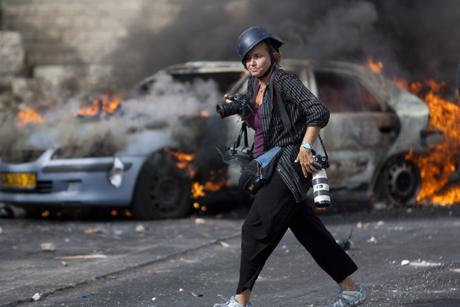
9-22-10 | Photo: Warrick Page
UPDATE 3/24/15: The International Women’s Media Foundation Honors Heidi Levine
By Pamela Burke/June 26, 2013
Photos Courtesy of Heidi Levine and Sipa Press
I stumbled upon a fascinating article about female conflict photographers in American Photo recently, and couldn’t take my eyes off a powerful photo of Syrian women crossing the border into Jordan shot by Heidi Levine.
It became a TWE Photo of the Week, and the beginning of a journey to find Heidi and interview her for the website. Her photos from some of the world’s most volatile war zones are unforgettable slices of life, the images so real that you think you are there.
“My only explanation of why I do this would be to say I can best describe this drive as a sort of ‘calling.’ It really makes me who I am.” Heidi Levine
Heidi surfaced in Israel, residing in a building where Jews and Arabs live together. It was important for her to live in this mixed neighborhood, she says, because it exposes her children to people from two very different backgrounds living side by side in peace.
There were many questions to ask this mother of three who is one of a special breed of female photographers covering areas of conflict in many parts of the world. Heidi was kind enough to answer our questions and to let us use her exceptional photographs. You can find Part Two here…
EYE: You have been called one of today’s top female conflict photographers. You’ve taken photographs of dangerous riots and documented some of the world’s most explosive war zones. What drives you to put yourself in these kinds of situations?
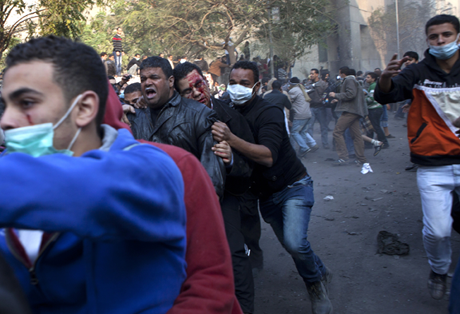
HEIDI: I have always been interested in helping people. When I was a kid, I volunteered and worked with mentally retarded children, worked as a candy striper in a hospital at the age of 14, worked with the elderly in their homes and in a nursing home and worked on a suicide hot line.
I was also obsessed with learning about the different underprivileged neighborhoods in the Boston and New York area. My father would take me along on a business trip to New York City and point me in the direction of a museum, but I would sneak off to Harlem. I was obsessed with studying sociology and psychology and really thought at the time I would become a sociologist or psychologist. I also really dreamed of becoming a doctor.
“I can honestly say, there have been moments that I had wished I were stopped because, yes, it is scary and dangerous.”
EYE: Do you think taking photographs became an extension of this desire to help people but in a different way?
HEIDI: In many ways all these experiences have been incorporated in the way I have tried to use the power of photography as my best tool to help others and make a difference.
It would be difficult to understand the force that drives me into the epic center of a conflict zone even when my own editors are advising me not to go.
I can honestly say, there have been moments when I wished I were stopped because, yes, it is scary and dangerous. My only explanation as to why I do this would be to say I feel that I can best describe this drive as a sort of ‘calling’. It really makes me who I am.
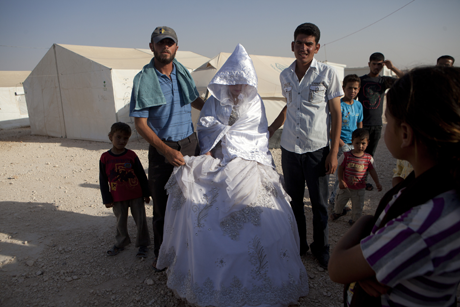
EYE: What made you decide you would make photojournalism your career? And how did you get involved in the conflict arena?
HEIDI: Both my parents are very creative people. They were young when I was born, just barely 20 years old themselves, and very hard-working. My father was very passionate about photography and for a period of time was working as a manager in a camera store.
He bought me my first camera and we would spend time together walking around Boston taking photographs. I took a photography class in high school but I was a bit of a rebel and was not as interested in taking pictures of still life as I was of taking pictures of people.
The Boston Globe and their incredible display of images from around the world heavily influenced me. Funny enough, I have an incredible connection to the Boston Globe, which I have also worked for on numerous accounts.
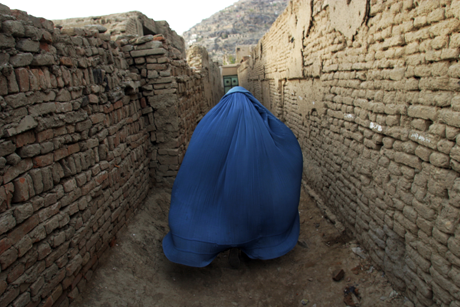
EYE: When did you begin to develop your talent and expertise as a photographer?
HEIDI: At the University of Massachusetts in Amherst, I worked as a photographer for the school newspaper, the Daily Collegian, and took my first journalism classes with Dr. Frank Faulkner. He was one of those great teachers in my life who really made a difference. He was a working journalist and a Vietnam vet who had also worked as a journalist during the war.
He told me that of all the students at that time, I really reminded him most of himself. When I went to Israel the first time during a summer break just to be on a kibbutz for six weeks and travel, I called the Associated Press in Israel from the contact I got from the Boston Globe picture editor.
After an interview that resulted in a job offer, I called my professor from a phone booth and asked his advice. He told me to grab the opportunity and that I would learn much more by actually workin than by learning in class. It was really that one phone call and his advice that set me on this path.
“The Israeli —Palestinian conflict was my first encounter with covering conflict and remains my most intimate.”
I also have a funny connection to the Boston Globe. I had my first front page of the Globe as a small kid but not as a photographer. My parents took me to a dog show in Boston and I climbed into the cage of one of the dogs. A Globe photographer captured the moment, and it was published on the first page. I guess I have been blessed to both be the subject on a front page and have my photographs published. Maybe it shows that from a very young age, it was in my blood to take risks.
I really got a great training at the AP. I got to do everything. I worked in the lab, edited and captioned pictures of others as well as my own and dealt with their subscribers. At the time I thought I would stay in the region for a year or two, not half of my life. The Israeli-Palestinian conflict was my first encounter with covering conflict and remains my most intimate.
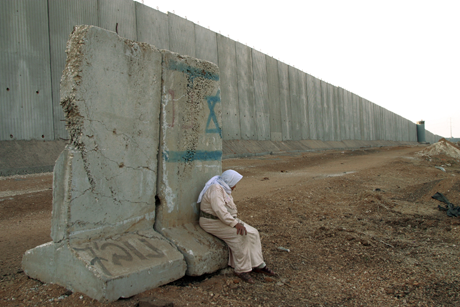
EYE: Did you have any particular mentors along the way or photographers you admired who inspired you to pursue this career?
HEIDI: Many photographers along the way influenced me. I have always admired Robert Capa, Henri Cartier-Bresson, Eugene Smith, Dorothy Lange, Margaret Bourke-White, Don McCullin, Nick Ut, Salgado, James Nachtway and others. I was surrounded by outstanding peers from the start such as Ron Haviv, Chris Morris, Les Stone, Alfred Yaghobzadeh, Alexandra Avakian, Alexandra Boulat, Ami Vitali, and Jerome Delay and was married to a photographer who covered conflict himself.
My boss at AP, Max Nash, was an amazing teacher who would every day tell me his own stories about covering Vietnam and working with Eddie Adams. I actually cooked him dinner when he came here. I was really blessed to meet and become friends with photographers and journalists from all over the world who are both experienced and new in the profession.
“Everyone is tied together by this same drive inside of him or her to try to expose what is happening and ideally try to make a difference.”
EYE: ‘Conflict’ photojournalism is not a profession that has historically been populated by women. Was it a struggle for you to be taken seriously in the beginning?
HEIDI: Yes, it was difficult. At the start I had to fight for it because I was also very young at the time, not just because I am a woman. When I wanted to go to Lebanon to cover the refugee crisis following the Lebanon—Israel war, I was very young. My boss did not want me to be exposed to danger because I had not yet become a mother. Later, once I was a mother, many felt it was irresponsible to place myself in danger because I was a mother.
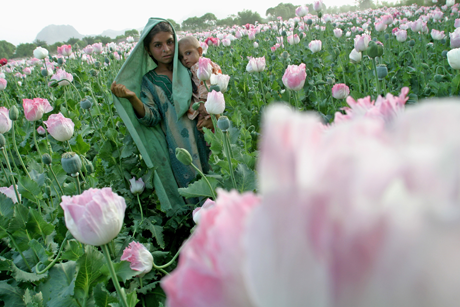
I had to fight my way in and then fight my way to be accepted into a profession that was, and still is to some degree, very much a boys’ club. In Libya, one Italian journalist I know shouted at me, “ Hey, what are you doing here, you have children,” but he did not shout at any of the males. For the most part, the men I work with truly respect what I do.
“I try my best to bond with the people I am documenting, and first of all, being a woman and even explaining at times that I am also a mother, often helps people trust me.”
EYE: Has being female worked to your advantage in some shooting situations? Does it give you better entrée when you are dealing with women and children who are sometimes in precarious positions?
HEIDI: Yes, it has given me more of an advantage for the intimate way I try to work than a disadvantage especially when covering cultures that have strict modesty rules such as in the Middle East and beyond. I am accepted into the bedroom of a woman in mourning more easily because I am a woman.
I try my best to bond with the people I am documenting, and being a woman and even explaining at times that I am also a mother, often helps people trust me. Sometimes, I am a bit of a novelty for people to meet in a war zone so they often try to protect me themselves and offer me a place to stay. Regardless of how bad the situation is, even if their home has been bombed to the ground, they offer me something to drink.

EYE: How close will you get to the action? In some of your photos, particularly those from Libya, it looks like you are positioned very near explosions, fire and gunfire.
HEIDI: Looking back on that day, I was lucky to be unharmed; it was too close. One truckload of ammunition caught on fire causing a large explosion, and others were flying aimlessly in all directions. At one point, I heard the whistling of a shell and could feel its incredible heat heading towards me. I ran, not looking back, running with the memories of every burn victim I had ever seen in my entire life, just hoping not to become the next burn victim.
On other occasions we would just hit the ground. In the desert, you have no protection, yet it is safer because a heavily populated area under bombardment turns into deadly shrapnel. On my second trip to Libya, I covered Tripoli. We followed a group of rebels who were fighting the last of Quaff forces still trying to resist defeat went right into a building.
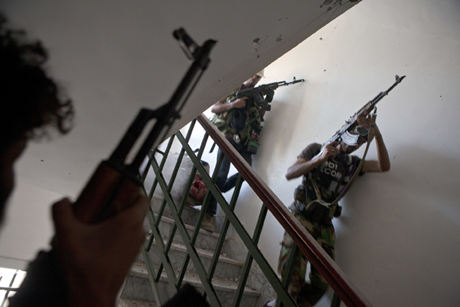
I was with other photographers and we were capturing images of the rebels firing in a stairwell just behind them when one of the rebels was shot dead by a sniper right in front of us. The loud crackling of gunfire brought greater confusion. I was lucky, we were all lucky, not to have been hit ourselves by the sniper.
EYE: Thanks so much for sharing your photographs and your sometimes- terrifying experiences, Heidi. There will be a Part Two with more pictures from your conflict shoots as well as your insight into what effect being a mom working in war zones has had on your career and your children.
###
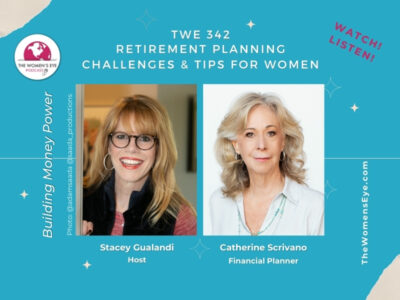
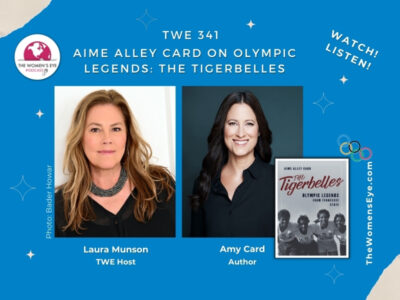

Very encouraging to all young aspiring girls and grown up women who would like to be photojournalists…i need to forward this to all my colleagues in our work of visual story telling…